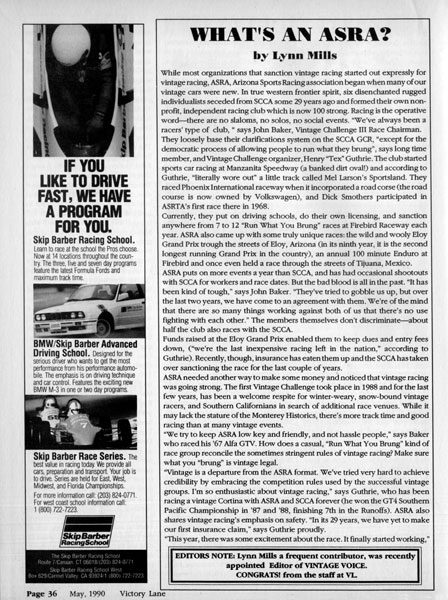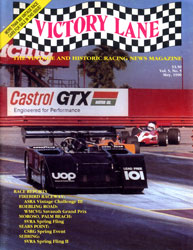
WHAT'S AN ASRA?
While most organizations that sanction vintage racing started out expressly for vintage racing, ASRA, Arizona Sports Racing Association began when many of our vintage cars were new. In true western frontier spirit, six disenchanted rugged individualists seceded from SCCA some 29 years ago and formed their own non-profit, independent racing club which is now 100 strong. Racing is the operative word -- there are no slaloms, no solos, no social events. "We've always been a racers' type of club," says John Baker, Vintage Challenge III Race Chairman.
They loosely base their clarifications system on the SCCA GCR, "except for the democratic process of allowing people to run what they brung," says long time member, and Vintage Challenge organizer, Henry "Tex" Guthrie. The club started sports car racing at Manzanita Speedway (a banked dirt oval!) and according to Guthrie, "literally wore out" a little track called Mel Larson's Sportsland. They raced Phoenix International raceway when it incorporated a road course (the road course is now owned by Volkswagen), and Dick Smothers participated in ASRA's first race their in 1968.
Currently, they put on driving schools, do their own licensing, and sanction anywhere from 7 to 12 "Run What You Brung" races at Firebird Raceway each year. ASRA also came up with some truly unique races: the wild and wooly Eloy Grand Prix through the streets of Eloy, Arizona (In its ninth year, it is the second longest running Grand Prix in the country), an annual 100 minute Enduro at Firebird and once even held a race through the streets of Tijuana, Mexico.
ASRA puts on more events a year than SCCA, and has had occasional shootouts with SCCA for workers and race dates. But the bad blood is all in the past. "It has been kind of tough," says John Baker. "They've tried to gobble us up, but over the last two years, we have come to an agreement with them. We're of the mind that there are so many things working against both of us that there's no use fighting with each other." The members themselves don't discriminate - about half the club also races with the SCCA.
Funds raised at the Eloy Grand Prix enabled them to keep dues and entry fees down, (We're the last inexpensive racing left in the nation," according to Guthrie). Recently, though, insurance has eaten them up and the SCCA has taken over sanctioning the race for the last couple of years.
ASRA needed another way to make some money and noticed that vintage racing was going strong. The first Vintage Challenge took place in 1988 and for the last few years, has been a welcome respite for winter-weary, snow-bound vintage racers, and Southern Californians in search of additional race venues. While it may lack the stature of the Monterey Historics, there's more track time and good racing than at many vintage events.
"We try to keep ASRA low key and friendly, and not hassle people," says Baker, who raced his '67 Alfa GTV. How does a casual "Run What You Brung" kind of race group reconcile the sometimes stringent rules of vintage racing? Make sure what you "brung" is vintage legal.
"Vintage is a departure from the ASRA format. We've tried very hard to achieve credibility by embracing the competition rules used by the successful vintage groups. I'm so enthusiastic about vintage racing," says Guthrie, who has been racing a vintage Cortina with ASRA and SCCA forever (he won the GT4 Southern Pacific Championship in '87 and '88, finishing 7yh in the Runoffs). ASRA also shares vintage racing's emphasis on safety. "In its 29 years, we hav yet to make our first insurance claim," says Guthrie proudly.
"This year, there was some excitement about the race. It finally started working."
Editor's Note: Lynn Mills is a frequent contributor and was recently appointed Editor of Vintage Voice.
CONGRATS! from the staff at VL..

